Themed collection RSC Advances Editors' collection: f Block Chemistry

Gadolinium(III) based nanoparticles for T1-weighted magnetic resonance imaging probes
This review summarized the recent progress on Gd(III)-based nanoparticles as T1-weighted MRI contrast agents and multimodal contrast agents.
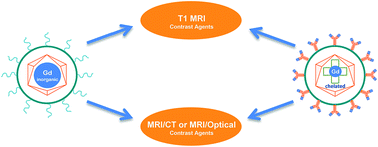
RSC Adv., 2016,6, 60945-60966
https://doi.org/10.1039/C6RA07782J
Photon conversion in lanthanide-doped powder phosphors: concepts and applications
Structural and optical properties of a lanthanide-doped material (Er3+, Yb3+ co-doped Y2SiO5 powder) prepared by combustion synthesis.
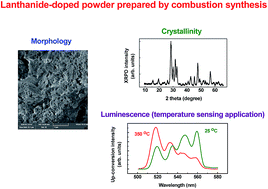
RSC Adv., 2015,5, 17283-17295
https://doi.org/10.1039/C4RA15804K
Luminescent lanthanide coordination polymers for photonic applications
Luminescent lanthanide coordination polymers composed of lanthanide ions and organic joint ligands exhibit characteristic photophysical and thermostable properties that are different from typical organic dyes, luminescent metal complexes, and semiconductor nanoparticles.
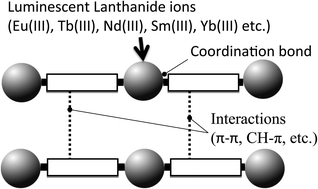
RSC Adv., 2015,5, 338-353
https://doi.org/10.1039/C4RA09255D
Time-resolved confocal microscopy using lanthanide centred near-IR emission
Time-resolved NIR imaging of lanthanide coated silica particles using Photon Arrival Time Imaging allows fast acquisition of high contrast images based on the probe luminescence lifetime.

RSC Adv., 2015,5, 70282-70286
https://doi.org/10.1039/C5RA15759E
Highly thermostable lanthanide metal–organic frameworks exhibiting unique selectivity for nitro explosives
The solvent-free Eu-MOF with high red emission intensity and the microporous instinct exhibits high sensitivity for 2,4,6-trinitrophenol with Ksv constant 6.24 × 104 M−1.
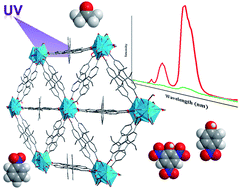
RSC Adv., 2015,5, 93-98
https://doi.org/10.1039/C4RA13773F
Dual modal imaging agents based on chromophore-bearing DTPA analogues
Two new DTPA analogues, centrally (L1) and terminally (L2) functionalised with a 1,8-naphthalimide chromophore, have been successfully prepared and fully characterized.

RSC Adv., 2017,7, 38463-38470
https://doi.org/10.1039/C7RA06946D
Rigid NON-donor pincer ligand complexes of lutetium and lanthanum: synthesis and hydroamination catalysis
A rigid NON-donor pincer ligand was employed for the synthesis of neutral lutetium and anionic lanthanum alkyl complexes; the former is highly active for both intra- and inter-molecular hydroamination.
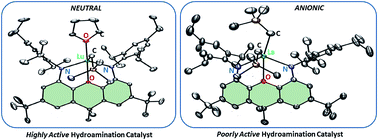
RSC Adv., 2017,7, 27938-27945
https://doi.org/10.1039/C7RA04432A
Optical detection of gadolinium(III) ions via quantum dot aggregation
CdTe quantum dot aggregation induced by trivalent metal ions is followed using fluorescence, dynamic light scattering and fluorescence correlation spectroscopy.
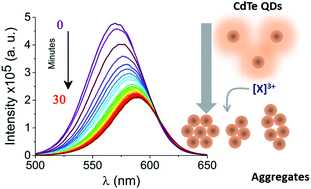
RSC Adv., 2017,7, 24730-24735
https://doi.org/10.1039/C7RA03969G
Direct covalent grafting of an organic radical core on gold and silver
A newly designed radical–anchor (R–A) molecule was synthesized and covalently grafted on Ag and Au surface at one atom distance preserving the molecular spin.
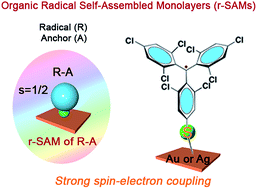
RSC Adv., 2017,7, 20076-20083
https://doi.org/10.1039/C7RA01686G
T 1 -Weighted MR/CT dual-modality imaging-guided photothermal therapy using gadolinium-functionalized triangular gold nanoprism
Triangular gold nanoprism decorated with gadopentetic acid (TGP–PEG–Gd) for PTT guided by T1-weighted MR/CT dual-modality imaging.
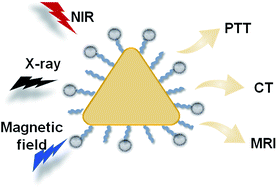
RSC Adv., 2017,7, 15702-15708
https://doi.org/10.1039/C7RA01101F
Structural properties, Judd–Ofelt calculations, and near infrared to visible photon up-conversion in Er3+/Yb3+ doped BaTiO3 phosphors under excitation at 1500 nm
The structural and up-conversion properties of BaTiO3 phosphors doped with Er3+/Yb3+ have been studied.
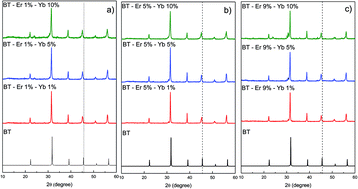
RSC Adv., 2017,7, 10529-10538
https://doi.org/10.1039/C6RA28725E
Single-component Eu3+–Tb3+–Gd3+-grafted polymer with ultra-high color rendering index white-light emission
Color-tuning to white-light (CIE coordinates of x = 0.322, y = 0.331; CCT of 5979 K; ultra-high CRI of 94) with a highly luminous efficiency (17.8%) was achieved for single-component Eu3+−Tb3+−Gd3+-grafted polymer Poly(MMA-co-2-co-3-co-4).

RSC Adv., 2017,7, 6762-6771
https://doi.org/10.1039/C6RA26724F
Selective signalling of sialic acid in solution by circularly polarised luminescence spectroscopy using a dynamically racemic europium(III) complex
Reversible binding of sialic acid to a phenylboronate derivative of a chiral europium(III) complex is signalled by a strong induced CPL signature.
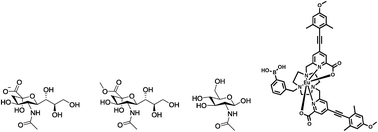
RSC Adv., 2017,7, 4531-4540
https://doi.org/10.1039/C6RA26662B
Color tunable emission and energy transfer in LaSi3N5:Ce3+,Tb3+ phosphors for UV white LEDs
Tunable blue-green-emitting LSN:0.09Ce3+,yTb3+ phosphors white-light UV LED.
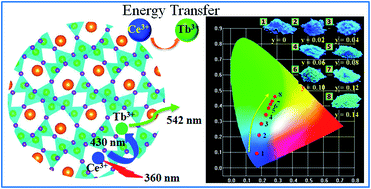
RSC Adv., 2017,7, 1075-1081
https://doi.org/10.1039/C6RA25915D
Complexation of NpO2+ with (2-hydroxyethyl)ethylenediaminetriacetic acid (HEDTA) in aqueous solutions: thermodynamic studies and structural analysis
The complexation of Np(V) with HEDTA in aqueous solutions was investigated by spectrophotometry, microcalorimetry and EXAFS. Thermodynamic parameters were determined and coordination modes also discussed.
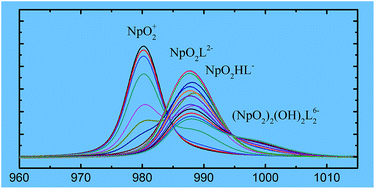
RSC Adv., 2016,6, 114916-114926
https://doi.org/10.1039/C6RA17818A
Luminescence, chemical sensing and mechanical properties of crystalline materials based on lanthanide–sulfonate coordination polymers
The relationship between the structural features with the mechanical, luminescent and sensing properties were studied in the compounds formed from lanthanide metals, 3-hydroxinaphthalene-2,7-disulfonate and 1,10-phenanthroline ligands.
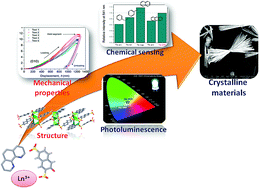
RSC Adv., 2016,6, 110171-110181
https://doi.org/10.1039/C6RA23516F
Study of the influence of magnetic dilution over relaxation processes in a Zn/Dy single-ion magnet by correlation between luminescence and magnetism
We investigate the magnetic dilution effect on the relaxation mechanisms and the estimation of the energy barrier in a photo-luminescent Dy(III)/Y(III) based Single-Ion Magnet (SIM).
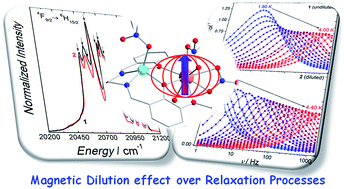
RSC Adv., 2016,6, 108810-108818
https://doi.org/10.1039/C6RA24115H
Functional heterocyclic molecular inclusion in p-sulfonatocalix[5]arene and lanthanide(III) complexes
p-Sulfonatocalix[5]arene either self-assemble in the presence of lanthanide ions into dense packed arrays of calixarenes or a grid-like arrangement comprising molecular capsules from adjacent bilayers, with the ‘molecular capsules’ confining small to large molecules.
![Graphical abstract: Functional heterocyclic molecular inclusion in p-sulfonatocalix[5]arene and lanthanide(iii) complexes](/en/Image/Get?imageInfo.ImageType=GA&imageInfo.ImageIdentifier.ManuscriptID=C6RA23283C&imageInfo.ImageIdentifier.Year=2016)
RSC Adv., 2016,6, 102695-102702
https://doi.org/10.1039/C6RA23283C
Circularly polarized luminescence reveals interaction between commercial stains and protein matrices used in paintings
Here we show that circularly polarized luminescence (CPL) can give unique insight into interactions between fluorescent commercial stains and protein-based materials used in painting. CPL can complement information from ECD and fluorescence.
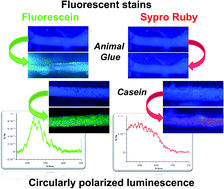
RSC Adv., 2016,6, 96176-96181
https://doi.org/10.1039/C6RA14795J
Efficient Nd3+ sensitized Yb3+ emission and infrared-to-visible energy conversion in gallium nano-garnets
We studied the structural and luminescence properties of nanocrystalline RE3Ga5O12 (RE = Gd, Y and Lu) garnets co-doped with 1 mol% of Nd3+ and 10 mol% of Yb3+ ions. The Nd3+ sensitized Yb3+ emission at 1025 nm is observed due to efficient Nd3+ to Yb3+ energy transfer.
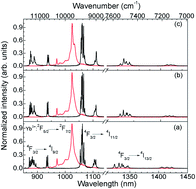
RSC Adv., 2016,6, 78669-78677
https://doi.org/10.1039/C6RA13729F
Superbroad near-infrared photoluminescence covering the second biological window achieved by bismuth-doped oxygen-deficient gadolinium oxide
We demonstrated that bismuth-doped oxygen-deficient gadolinium oxides, produced through a low-temperature topochemical reduction strategy using CaH2 as a solid-state reducing agent, show superbroad NIR PL covering the second biological window.
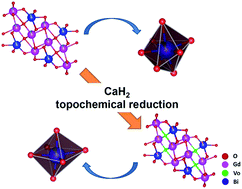
RSC Adv., 2016,6, 78396-78402
https://doi.org/10.1039/C6RA14389J
Thermodynamic calculations of oxygen self-diffusion in mixed-oxide nuclear fuels
Molecular dynamics calculations are used to provide a self-consistent prediction of the elastic, thermal expansion and oxygen self-diffusion properties of mixed oxide nuclear fuels at arbitrary compositions.
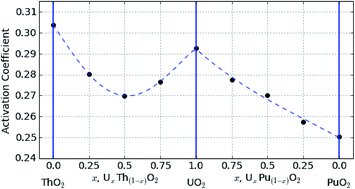
RSC Adv., 2016,6, 74018-74027
https://doi.org/10.1039/C6RA14424A
Near-infrared luminescence of Nd3+ and Yb3+ complexes using a polyfluorinated pyrene-based β-diketonate ligand
Highly efficient near-infrared emitting Nd3+ and Yb3+ complexes have been developed based on a new polyfluorinated pyrene-appended β-diketonate ligand.

RSC Adv., 2016,6, 69509-69520
https://doi.org/10.1039/C6RA12220E
Temperature-, power-, and concentration-dependent two and three photon upconversion in Er3+/Yb3+ co-doped lanthanum ortho-niobate phosphors
Variation of two and three photon upconversion band intensities in LNO:Er1%–Yb7.5% phosphor with temperature.
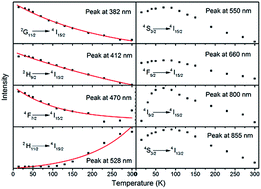
RSC Adv., 2016,6, 68160-68169
https://doi.org/10.1039/C6RA12941B
A gadolinium MOF acting as a multi-responsive and highly selective luminescent sensor for detecting o-, m-, and p-nitrophenol and Fe3+ ions in the aqueous phase
A new Gd-MOF constructed with a π-conjugated ligand shows highly luminescent selective sensing of o-, m-, and p-nitrophenol and Fe3+ ions in an aqueous system.

RSC Adv., 2016,6, 61725-61731
https://doi.org/10.1039/C6RA07244E
Multifunctional β-NaGdF4:Ln3+ (Ln = Yb, Er, Dy) nanoparticles with NIR to visible upconversion and high transverse relaxivity: a potential bimodal contrast agent for high-field MRI and optical imaging
Developed nano β-NaGdF4 doped with Yb3+/Er3+ in the core and Yb3+/Dy3+ in the shell with favorable properties for combined magnetic resonance and optical imaging.

RSC Adv., 2016,6, 61443-61448
https://doi.org/10.1039/C6RA09450C
Gadolinium oxysulfide nanoprobes with both persistent luminescent and magnetic properties for multimodal imaging
Gd2O2S doped with Eu3+ (5%), Ti4+ (1%), Mg2+ (8%) nanoprobes combine optical imaging agent with persistent luminescence properties and a worthy MRI contrast with a high T1 effect.
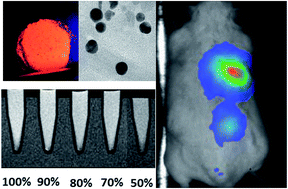
RSC Adv., 2016,6, 55472-55478
https://doi.org/10.1039/C6RA05030A
Crystal structure, luminescence properties and energy transfer of Eu3+/Dy3+ doped GdNbTiO6 broad band excited phosphors
GdNbTiO6 has been used as a broad band excited host material absorbing UV radiation, and the excitation energy is transferred from the O2− → Nb5+(Ti4+) charge transfer band to the excited states of Eu3+/Dy3+ ions, presenting different emission colors.
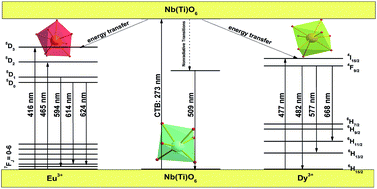
RSC Adv., 2016,6, 50797-50807
https://doi.org/10.1039/C6RA08284J
A turn on fluorescent sensor based on lanthanide coordination polymer nanoparticles for the detection of mercury(II) in biological fluids
Im-quenched fluorescence of Eu/IPA CPNPs can be recovered upon the addition of Hg2+ through the formation of a Hg/Im complex.

RSC Adv., 2016,6, 17811-17817
https://doi.org/10.1039/C5RA26849D
Ultrasensitive electrochemical detection of UO22+ based on DNAzyme and isothermal enzyme-free amplification
A novel enzyme-free amplification biosensor for uranyl detection was developed based on UO22+-specific DNAzyme and a hybridization chain reaction.
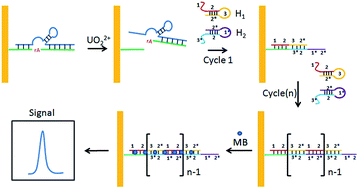
RSC Adv., 2016,6, 3960-3966
https://doi.org/10.1039/C5RA22773A
A novel heterobimetallic Ru(II)–Gd(III) complex-based magnetoluminescent agent for MR and luminescence imaging
A novel heterobimetallic ruthenium(II)–gadolinium(III) complex, Ru–Gd, has been developed for luminescence and an vivo T1-weighted MR imaging agent.
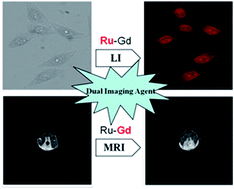
RSC Adv., 2015,5, 96525-96531
https://doi.org/10.1039/C5RA18544K
Anionic phenoxy-amido rare-earth complexes as efficient catalysts for amidation of aldehydes with amines
A series of anionic organo-rare-earth amido complexes stabilized by dianionic phenoxy-amido ligands were synthesized, and their catalytic property for the amidation reactions of aldehydes with amines was explored.

RSC Adv., 2015,5, 94768-94775
https://doi.org/10.1039/C5RA20285J
A luminescent europium MOF containing Lewis basic pyridyl site for highly selective sensing of o-, m- and p-nitrophenol
A new Eu–MOF constructed by a multidentate ligand with a Lewis basic pyridyl site shows highly luminescent selective sensing of the o-, m- and p-nitrophenol.
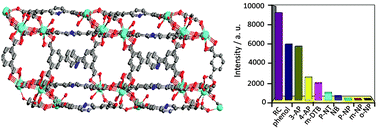
RSC Adv., 2015,5, 86614-86619
https://doi.org/10.1039/C5RA17001J
Polyhydroxylated GdDTPA-derivatives as high relaxivity magnetic resonance imaging contrast agents
Novel GdDTPA-like complexes bearing differently branched, highly hydrophilic, gluconyl moieties were synthesized to obtain high relaxivity agents (∼20 mM−1 s−1 at 25 °C) over a wide range of imaging fields (0.5–3 T).
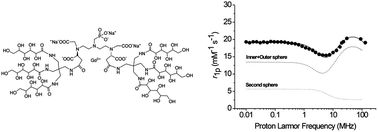
RSC Adv., 2015,5, 74734-74743
https://doi.org/10.1039/C5RA15071J
Spectroscopic markers for uranium(VI) phosphates: a vibronic study
Uranyl phosphate minerals are studied by optical and vibrational spectroscopy which provide robust markers to discriminate among environmentally hazardous uranium phases.

RSC Adv., 2015,5, 71219-71227
https://doi.org/10.1039/C5RA13558C
Improved stability and enhanced efficiency of dye sensitized solar cells by using europium doped yttrium vanadate down-shifting nanophosphor
YVO4:Eu3+ nanophosphor improves long-term stability of DSSCs under illumination, due to down-shifting of high energy UV photons to the visible region.
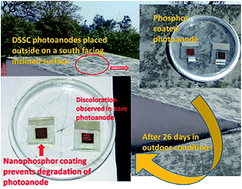
RSC Adv., 2015,5, 66057-66066
https://doi.org/10.1039/C5RA10067D
Slow magnetic relaxation of a three-dimensional metal–organic framework featuring a unique dysprosium(III) oxalate layer
Two-step thermal magnetic relaxation was observed in a novel three-dimensional dysprosium(III) metal–organic framework.
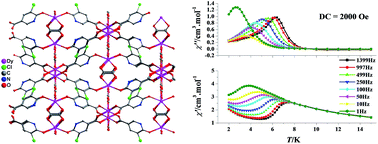
RSC Adv., 2015,5, 63186-63192
https://doi.org/10.1039/C5RA11621J
Application of a tailor-made polymer as a selective and sensitive colorimetric sensor for reliable detection of trace levels of uranyl ions in complex matrices
In this study, a new colorimetric chemosensor based on ion imprinted polymer nanoparticles was designed for quantitative detection of uranyl ions at trace levels in environmental water samples.

RSC Adv., 2015,5, 59912-59920
https://doi.org/10.1039/C5RA09221C
Intense red emitting monoclinic LaPO4:Eu3+ nanoparticles: host–dopant energy transfer dynamics and photoluminescence properties
Visible host emission and dynamics of host–dopant energy transfer in LaPO4:Eu phosphor is investigated using PL and complimented by DFT.
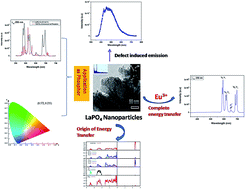
RSC Adv., 2015,5, 58832-58842
https://doi.org/10.1039/C5RA09076H
Lanthanum loaded CuO nanoparticles: synthesis and characterization of a recyclable catalyst for the synthesis of 1,4-disubstituted 1,2,3-triazoles and propargylamines
A click and three component A3 coupling reactions were achieved by lanthanum loaded CuO NPs under ultrasonication. 1,4-Disubstituted 1,2,3-triazoles and propargylamines were synthesized in a short reaction time with high regioselectivity and yields.
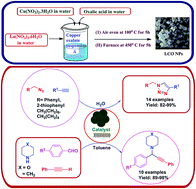
RSC Adv., 2015,5, 56507-56517
https://doi.org/10.1039/C5RA05468K
Investigation into the temperature sensing behavior of Yb3+ sensitized Er3+ doped Y2O3, YAG and LaAlO3 phosphors
The sensitivities (S) of Y2O3 (YAG/LaAlO3):Yb3+/Er3+ phosphors increased with increasing average bond covalency and the calculated values were basically in good agreement with our experimental results.
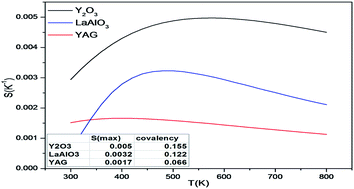
RSC Adv., 2015,5, 51820-51827
https://doi.org/10.1039/C5RA05986K
A terbium metal–organic framework with stable luminescent emission in a wide pH range that acts as a quantitative detection material for nitroaromatics
This work reports a fascinating Tb-MOF which can efficiently and quantitatively detect nitroaromatics and maintain stable luminescent emission in a wide pH range.
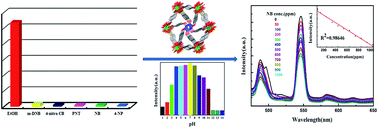
RSC Adv., 2015,5, 48574-48579
https://doi.org/10.1039/C5RA06308F
Uranium(VI) complexes with isonicotinic acid: from monomer to 2D polymer with unique U–N bonding
Two uranium(VI) complexes with isonicotinic acid, exhibiting a monomer and a 2D polymer, have been synthesized and characterized.
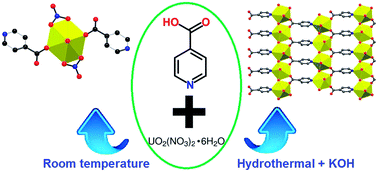
RSC Adv., 2015,5, 33249-33253
https://doi.org/10.1039/C5RA01272D
A strong charge-transfer effect in surface-enhanced Raman scattering induced by valence electrons of actinide elements
The 6d electrons of Ac atom involved in excited transitions induce a strong CT-SERS enhancement which can be tuned by changing the conformation of pyridine-Ac@Au7 complexes.
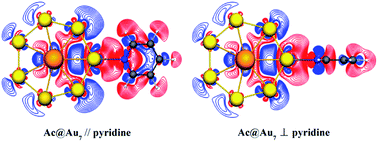
RSC Adv., 2015,5, 32198-32204
https://doi.org/10.1039/C5RA03408F
Recent advances in f-element separations based on a new method for the production of pentavalent americium in acidic solution
A reliable method for the quantitative production of pentavalent americium in acidic solution.
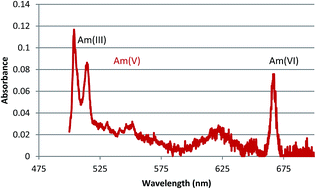
RSC Adv., 2015,5, 27205-27210
https://doi.org/10.1039/C5RA03196F
A new anionic metal–organic framework showing tunable emission by lanthanide(III) doping and highly selective CO2 adsorption properties
A 3D porous anionic MOF (1), decorated with -NH2 and N sites, can serve as a host for the encapsulation of lanthanide(III) cations for emission tuning. Besides, it also shows high adsorption selectivity for CO2 over CH4 and N2 at 273 K.
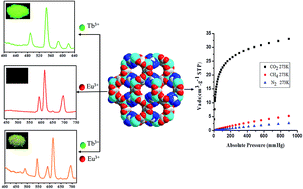
RSC Adv., 2015,5, 24655-24660
https://doi.org/10.1039/C5RA02935J
A series of heterospin complexes based on lanthanides and pyridine biradicals: synthesis, structure and magnetic properties
Six LnIII-biradical tri-spin complexes have been synthesized, and they exhibit interesting magnetic properties.
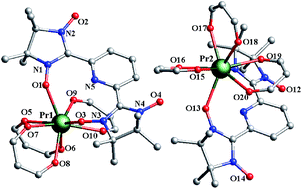
RSC Adv., 2015,5, 17131-17139
https://doi.org/10.1039/C4RA15074K
Room temperature crystallization of highly luminescent lanthanide-doped CaF2 in nanosized droplets: first example of the synthesis of metal halogenide in miniemulsion with effective doping and size control
We report the first example of crystalline and luminescent lanthanide-doped CaF2 nanostructures synthesised in the confined space of miniemulsion at room temperature.
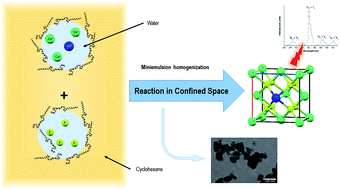
RSC Adv., 2015,5, 16302-16310
https://doi.org/10.1039/C4RA12006J
Size-dependent upconversion luminescence and temperature sensing behavior of spherical Gd2O3:Yb3+/Er3+ phosphor
In this paper, we found that sensing sensitivity increases with decreasing the particle size, which was confirmed by the Judd–Ofelt theory.

RSC Adv., 2015,5, 14123-14128
https://doi.org/10.1039/C4RA13204A
Application of chiral ligands: carbohydrates, nucleoside-lanthanides and other Lewis acid complexes to control regio- and stereoselectivity of the dipolar cycloaddition reactions of nitrile oxides and esters
Enantioselectivity of the cycloaddition up to 99.8%.
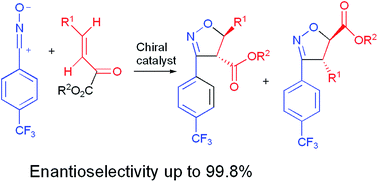
RSC Adv., 2015,5, 13112-13124
https://doi.org/10.1039/C4RA15975F
About this collection
Guest edited by Professor Mike Ward, Editor-in-Chief, University of Warwick, UK
The chemistry of the f-block elements is a microcosm of modern chemistry as a whole. From being a relatively under explored-section of the periodic table last century when transition-metal organometallic and then metallo-suprmolecular chemistry were huge growth areas, the f-block elements have caught up because of the remarkable combination of useful properties that they provide. The lanthanides alone make a substantial contribution to leading developments in areas as diverse as single-molecule magnetism, medical imaging and homogeneous and heterogeneous catalysis; and their luminescence properties alone are exploited for applications in cell imaging, optical communications, sensing and analysis, and efficient lighting. Actinide chemistry is of course dominated by issues related to nuclear fuel processing, and analytical methods associated with detection of radionuclides in the environment. In this collection of 50 articles published in RSC Advances from 2015 you will find a cross section of current developments in f-block chemistry that are helping to define the state-of-the-art, and I hope you enjoy browsing through them.